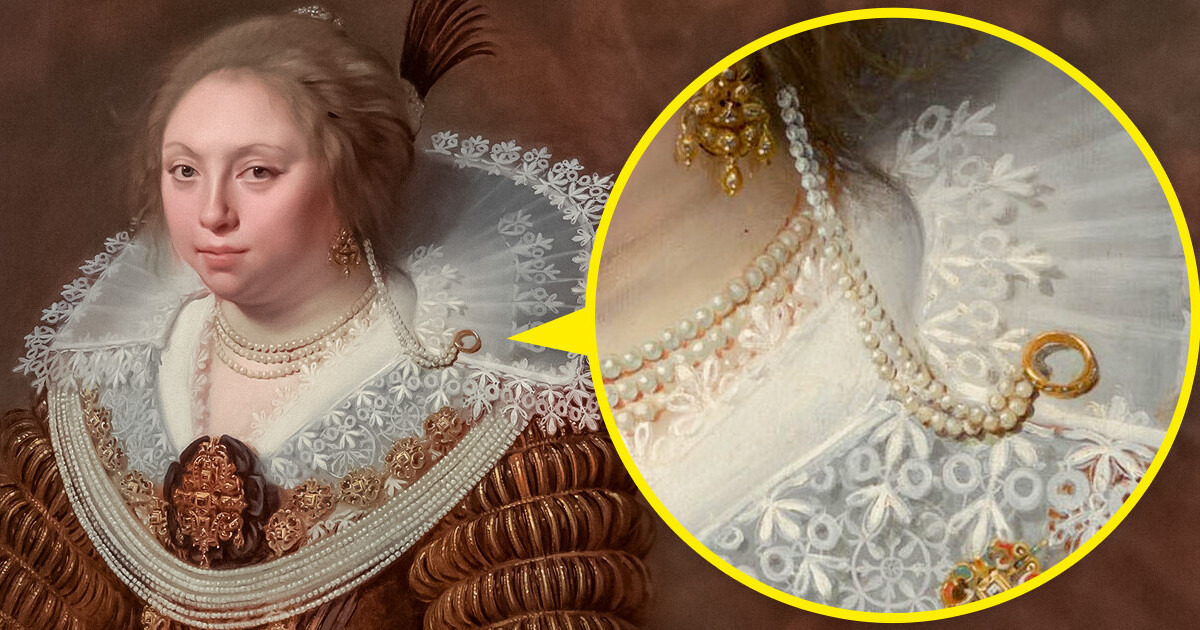I Did a DNA Test for My Baby and Accidentally Uncovered My MIL’s Secret


Scientists believe that the first jewelry appeared in the Neolithic era. But even then, people may have worn jewelry not only for beauty or “protection from evil forces,” but also to show off their wealth to everyone else. Nowadays, some pieces that were fashionable in the past centuries might seem really weird. But everything becomes even more interesting when you find out what purpose they actually had.
In the late 15th century, ladies wore tall cone-shaped headdresses, also called the hennin. These accessories were made of light materials (cardboard or thin wire) and were covered with fabric. Some ladies wore hennins with veils, while others covered the headdress with strips of heavy fabric.
To prevent the fabric from slipping, it was pinned to the cone with decorative clasps that looked like a brooch with a pin.
These jewelry pieces were attached to the hair or headdress in such a way that the pendant dangled gracefully near the cheek or temple. These pendants were worn not only for beauty. Researchers suggest that a cloth soaked in incense was placed inside the pendant, so that the noble lady didn’t have to suffer from bad odors.
And the metal stick, most likely, was needed to pull the cloth out of the pendant and push it back in.
In the beginning of the 16th century, noble ladies in Germany became quite fond of gold jewelry. They tried to wrap as many gold chains around their necks as possible. This fashion trend is especially vividly represented in the painting by Lucas Cranach, who depicted Anna Buchner (it is her you can see in the photo above). The top of her dress can’t be seen because of the pile of massive chains.
Another popular piece of jewelry was a set of 5 rings. Women wore them on various fingers, including the thumb and upper joints. We counted at least 12 rings on Anna’s portrait.
Alas, pockets were rarely a part of a woman’s dress, while it was inconvenient to carry everything you needed in your hands — keys, needles, cutlery, perfume bottles. Back in ancient Rome, there was an item that was later called a chatelaine. What was it for? Women wore nail clippers and other small things on thin chains attached to a ring.
By the 18th century, chatelaines gained huge popularity, they were used by both noble ladies and common women. Wealthy women usually ordered pieces made of precious metals and decorated with diamonds and other precious stones.
In the late 15th century in many European countries, noble ladies tried to hide their hair under headdresses, but Italian women were not afraid to show off their lush locks. With the help of silk ribbons, pearls and wires, young ladies created intricate hairstyles on their heads. But the main piece was a heavy brooch, which was attached to the top of the head.
At the end of the 15th century, Milanese ladies were not afraid to show off their family’s wealth by wearing outfits adorned with precious metals and stones. Not all people liked this fashion trend — the ladies of Milan were mercilessly ridiculed. But not only the exquisite dresses shook the imagination of contemporaries. Their hairstyles were also very fancy.
The hair was divided into a straight parting, after that the ponytail was wrapped in cloth, and its top was wrapped with a ribbon embroidered with pearls. The back of the head was covered with a fine net decorated with precious stones. And the whole thing was fixed with a silk cord. We can’t even imagine what it was like to walk with this construction on the head. The girl in the portrait above decided to add a luxurious brooch, with her family motto inscribed on it, to her hairstyle.
In the 16th and 17th centuries, aiglets adorned both men’s and women’s outfits. And this detail wasn’t only for decoration. With the help of aiglets, women hid seams and rips in their dresses. However, seemingly, nobles used to lose them quite often, so they ordered them in batches.
In the 17th century, young ladies wore lush dark dresses, not out of modesty. Black dye was one of the most expensive, so these outfits signified the enviable wealth of the wearer. However, ladies tended to add bright spots to their outfits with a lot of jewelry. Pearls and rings were particularly popular.
At some point, women were told that overly luxurious wedding rings were indecent. From that moment on, it was necessary to wear a simple gold band. So to make sure this modest piece of jewelry wouldn’t get lost among the other fancy rings, women began to wear wedding rings on chains or laces around their necks.
When high collars became fashionable, women began to hide their hair under white caps. To keep the headdress from looking too boring, ladies decorated it with pearl hairpins. But that’s not all.
Married ladies pinned the pearl on the right side. One woman even ordered a pin with the image of a castle to show how much she was devoted to her husband. Engaged women wore the pin on the left side. While single ladies were not supposed to wear this pin at all.
The pin usually protruded slightly from under the cap, so an interested gentleman could immediately see whether the lady he was interested in was available.
In the early 17th century, Medici collars were particularly popular among fashionistas. These ruff pieces could be very tall and gracefully framed a lady’s face. To keep the collars from falling off, women used wire and starch. Some items were decorated with jewelry. For example, the woman in the portrait above has pendants and a ring attached to her collar.
During the Renaissance, the most popular jewelry were pendants, and they were worn not only around the neck but also on the belt. Pendants, richly decorated with precious stones, usually hung on a chain, which was either loose around the neckline or attached to the dress. Some noble ladies encoded their own initials or the name of their lover in the pendants.
Unfortunately, this type of jewelry wasn’t inherited, and was mostly destroyed after the owner’s death.
In the 15th and 16th centuries, jewelers left cavities in some rings on purpose. A wearer could put aromatic substances inside. In those times, personal hygiene was, to put it mildly, far from ideal, and the odors hovering at parties and balls could knock one off one’s feet. If a bad smelling person stood right next to a lady, she could put the ring to her nose and smell it.
In the 17th century, women were not afraid to show off their wealth and literally covered themselves in jewelry. However, some jewelry could tell a little more about the personal life of its wearer.
Ermgard Elisabeth van Dorth, pictured in the portrait above, lost her fiancé when she was 23 years old. Some researchers speculate that the gold ring, attached by a string of pearls to her hair, was once given to her by her beloved one. So, this piece could symbolize her grief.
And if you always wanted to buy a piece of jewelry from a famous movie, here you can find out how you can do it.











